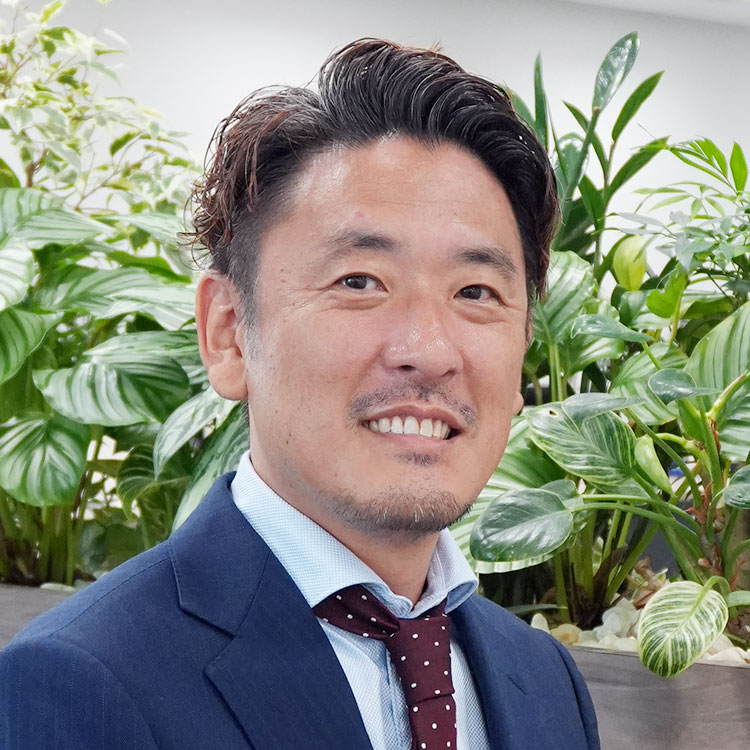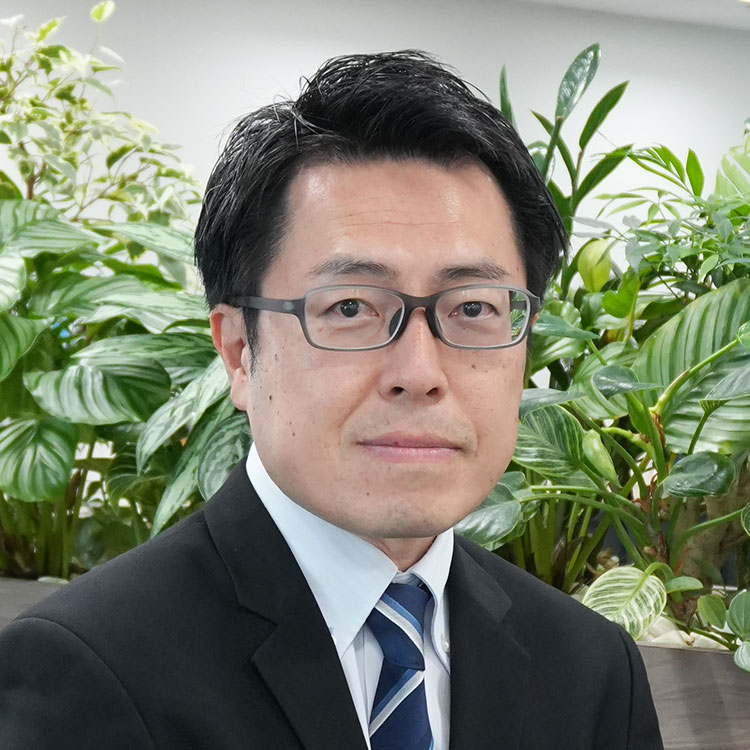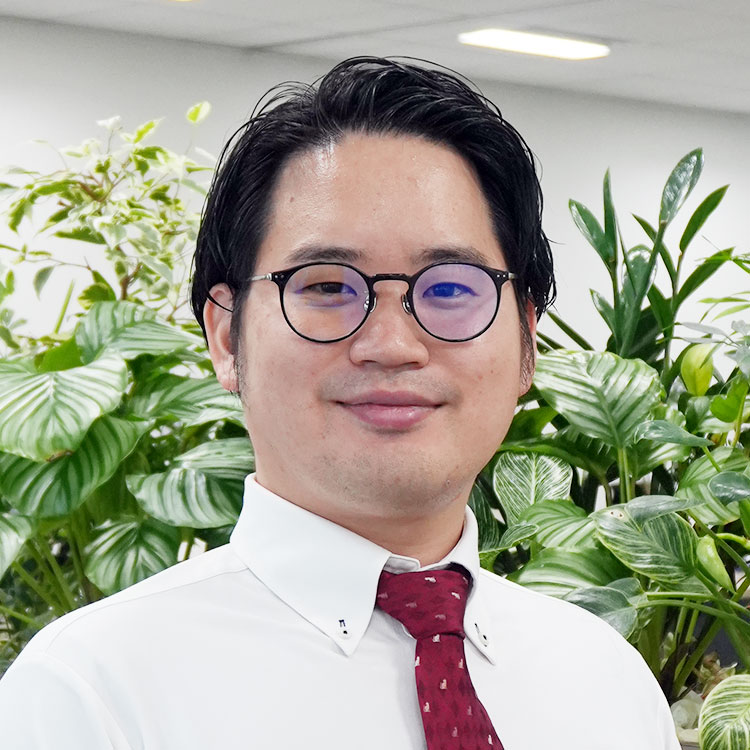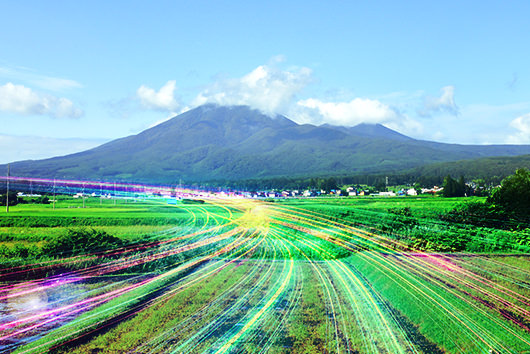The sewerage accident in Yashio City, Saitama Prefecture, has raised concerns about the current state of water and sewerage infrastructure and its future maintenance. A national expert panel has compiled recommendations with unprecedented speed, making unprecedentedly bold proposals, such as "ensuring redundancy and maintainability," "reviewing pipeline planning and design," and "actively promoting wide-area collaboration, including technical staff," calling for fundamental improvements. We talked to three people at PACIFIC CONSULTANTS who are in charge of water and sewerage projects: Masayuki HACHIUMA, General Manager of Water Supply & Sewage Dept., Land Infrastructure Div.; Masafumi NIIHIRA of the Sewerage Design Sec. within the same department; and Mitsuru AMANO of Water Circulation Design Sec., about what specific measures will be needed going forward.
INDEX
- What the Yashio City road collapse accident revealed
- Water and sewerage facilities are at increasing risk of deterioration
- A rapid succession of proposals
- What you need to think about now
- A comprehensive perspective required for policy planning
What the Yashio City road collapse accident revealed
A large-scale road collapse caused by a broken sewer pipe occurred in Yashio City, Saitama Prefecture on January 28, 2025. The truck driver involved was killed, and approximately 1.2 million people were asked to refrain from using the sewer system for an extended period of time, severely impacting the lives of local residents. Emergency restoration work, including the laying of a 70-meter bypass pipe, took three months, and full restoration work is expected to take another five to seven years.
Water and sewerage facilities are at increasing risk of deterioration
Moreover, the risk of aging that this accident showed is not limited to Yashio City, but exists in all water supply and sewerage pipelines, water purification plants, and sewage treatment facilities across the country. The total length of water pipes nationwide is approximately 740,000 km (as of the end of fiscal year 2021), but currently, approximately 170,000 km (about 22% of the total) of pipelines have exceeded their legal useful life of 40 years. This will rapidly increase to approximately 300,000 km (about 41%) in 10 years and to approximately 490,000 km (about 66%) in 20 years.
Even today, there are more than 20,000 water leak and damage accidents per year. Most recently, in the early hours of April 30th, a water pipe burst on a national highway in Kyoto City, flooding the road. The damaged water pipe was an old pipe that had been installed for over 65 years. Also, on May 30th, a water pipe broke in Oura Higashimachi, Nagasaki City, causing the road to cave in. The damaged water pipe was a cast iron pipe installed approximately 100 years ago. Furthermore, on June 28th, a water pipe burst in Kamakura City, causing a widespread water outage and requiring the dispatch of water trucks.
Furthermore, of the current total length of approximately 500,000 km (as of the end of fiscal year 2023), approximately 40,000 km (about 7% of the total length) have exceeded their standard service life of 50 years. However, this will rapidly increase to approximately 100,000 km (about 20%) in 10 years and to approximately 210,000 km (about 42%) in 20 years. Moreover, as the sewer pipes in Yashio City in this case were installed 42 years ago, depending on the environment, they may suffer damage before the 50-year mark. According to a survey by the Ministry of Land, Infrastructure, Transport and Tourism, there will be more than 2,600 road collapses caused by sewer pipes in Japanese fiscal year 2022.
Not only are pipelines aging, but facilities are also aging. Many water purification plants have been in operation for over half a century, and as of 2022, only just over 43% of facilities are earthquake-resistant. Of the approximately 2,200 sewage treatment plants nationwide (as of the end of fiscal year 2022), approximately 2,000, or 90%, of the total have exceeded the standard 15-year service life of their mechanical and electrical equipment. The vulnerability of water supply and sewerage facilities was clearly evident in the Noto earthquake that occurred on January 1, 2024, which left up to approximately 110,000 households in six cities and towns in the Noto region without water. Restoration took time, and it was not until May 31st, six months later, that water was restored. Furthermore, 15 of the 20 sewage treatment plants suffered damage.
However, the number of local government employees involved in maintenance and management has decreased significantly. The number of employees involved in water supply projects has decreased by approximately 37% compared to its peak, and for sewerage projects it has decreased by approximately 43%. Furthermore, for small utilities serving a population of less than 10,000, the average number of employees is four for water supply projects and two for sewerage projects. In terms of manpower as well, it must be said that the maintenance and management of water supply and sewerage systems is in an extremely difficult situation.
Number of employees in the water supply and sewerage business

Number of employees by population size
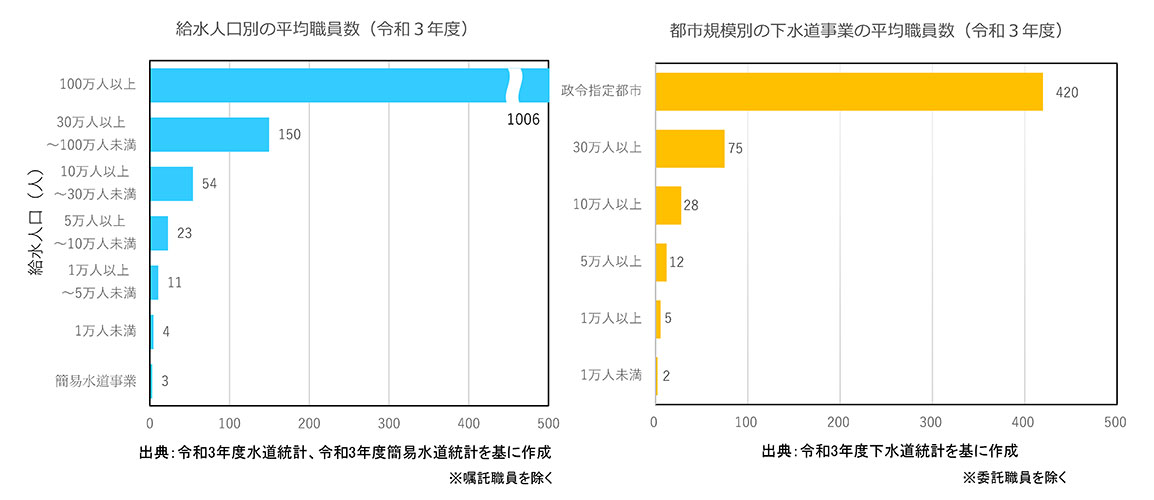
A rapid succession of proposals
In April 2024, the national government reformed the water supply and sewerage administration for the first time in 60 years, unifying the existing two main bodies, "Ministry of Health, Labor and Welfare for water supply and Ministry of Land, Infrastructure, Transport and Tourism for sewerage," into a single body, Ministry of Land, Infrastructure, Transport and Tourism. The "Basic Policy Study Group for Water Supply and Sewerage" was established by Ministry of Land, Infrastructure, Transport and Tourism and held its first meeting in November 2024, but due to the accident in Yashio City that occurred two months later, the content and schedule of the study were suddenly changed. In May, the second round of recommendations was made on "Realization of Pipeline Management that Places the Highest Priority on Safety. Committee Chairman Satoshi TAKIZAWA commented, "The Yashio accident made us realize once again how wide the scope of impact would be in the event of a large-scale accident. We also realized that there are many different underground conduits, and that if a problem or accident were to occur in one conduit, it would affect other conduits as well. The underground infrastructure and pipeline infrastructure that we have built up so far in Japan has a very complicated structure underground that we are usually unaware of. What we should do to prevent accidents like the one in Yashio City from happening again is an urgent issue" (minutes of the meeting). In fact, the second proposal called for drastic measures with an unprecedentedly strong sense of urgency.
What you need to think about now
The second proposal first lists six basic points.
| 1 | The concentration of hydrogen sulfide is high, and the water level in the pipes is high (high flow rate) under normal circumstances. There is no alternative route, making maintenance of the sewer pipes difficult. |
| 2 | Ensuring safety in sewerage pipelines is the top priority. |
| 3 | Promoting technological advances in inspections and surveys and reducing the costs of these technologies. |
| 4 | Advancement of digital management of underground spaces. |
| 5 | Ensuring maintainability and redundancy. |
| 6 | Strengthening the foundations in both technical and financial terms through wide-area collaboration, setting appropriate usage fees, etc. |
Furthermore, the following five important measures have been proposed based on this basic concept.
① Ensure inspections are carried out based on the level of urgency
Priorities will be set based on two axes: The likelihood of damage occurring and the magnitude of the social impact, thereby achieving more frequent and sophisticated inspections.
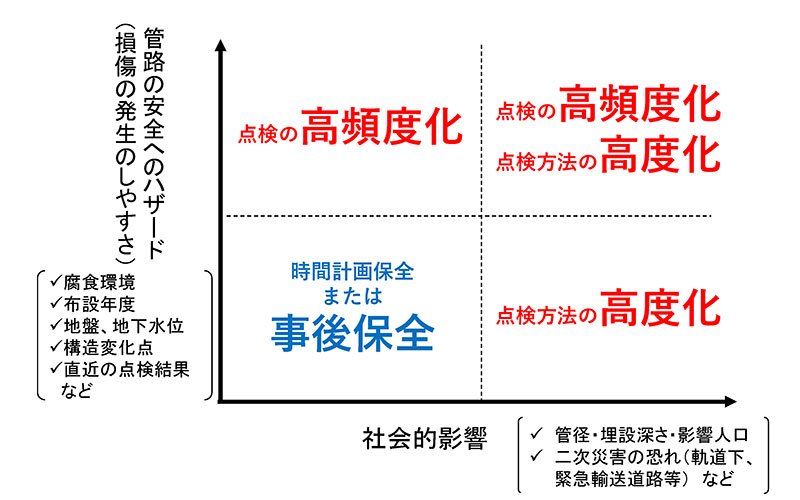
source: "Second Recommendation - Protecting Basic Infrastructure: Water Supply and Sewerage Systems Together with the People" May 28, 2025 (Ministry of Land, Infrastructure, Transport and Tourism)
② Digitization and integration of underground space information
By digitizing and integrating information such as information on objects buried underground, results of subsurface cavity surveys, and road collapse history, the company aims to establish advanced inspection technology and reduce costs. Specifically, it is considering the introduction of multi-functional manhole covers (measuring hydrogen sulfide concentrations inside pipes and transmitting information in real time) and fiber optic sensors.
3) Review of conventional design guidelines
In order to avoid overlapping of the three weak points in sewerage systems - chemistry, mechanics, and soil - existing plans and design guidelines will be reviewed, for example by using sulfate-resistant concrete in sharply curved sections of the shield and strengthening the surrounding area with ground improvement work.
④ Accelerating the establishment of redundancy
Since it is difficult to repair sewerage systems or to quickly restore them in the event of a disaster or accident, we will work to ensure redundancy by promoting multiplexing and decentralization, such as by duplicating and double-tracking pipelines.

⑤ Promoting wide-area collaboration
Considering the limitations of individual municipalities in running water and sewerage businesses "Regional Infrastructure Cluster Regeneration Strategy Management" (Cluster Management), we will actively consider wide-area collaboration among local governments based on this idea, as well as "human swarm management," in which technical staff from local governments work together.
A comprehensive perspective required for policy planning
The Expert Panel's "Second Recommendation" indicates that infrastructure management in Japan must be elevated to a new level. While many local governments find themselves in a situation where they know what needs to be done but are unable to do so due to a lack of personnel and budget, the Recommendation outlines practical measures such as prioritizing inspections, accelerating the digitalization of maintenance and management, reviewing the design of high-risk areas, and promoting wide-area collaboration, particularly human resource management. It also offers a long-term perspective, such as promoting redundancy. Learning from the damage caused by the Great Hanshin-Awaji Earthquake, seismic reinforcement of railway and road viaducts has progressed steadily across the country, albeit over a long period of time, and no similar damage has occurred since then. The Recommendation also emphasizes the need for "steady policy efforts."
PACIFIC CONSULTANTS has contributed to the stable supply and recycling of clean water, the development, maintenance, and renewal of sewerage facilities, and disaster-resistant urban development through the planning, design, and management of regional water infrastructure, primarily focusing on water and sewerage projects. In particular, we have not only specialized engineers in the water and sewerage field, but also experts in the fields of river and port water systems, structures, roads, ground, architecture, machinery, electricity, and digital transformation, as well as carbon neutrality, the environment, and PPP/PFI projects, and we use our comprehensive capabilities to meet the needs of various local governments across the country.
Recently, we have carried out feasibility studies and provided advisory services for the introduction of PPP/PFI methods for the renewal of aging treatment plants. We have also supported multiple feasibility studies for the water PPP business, which has been a hot topic in recent years. Wide-area collaboration is an unavoidable consideration for future water and sewerage infrastructure maintenance and management measures, and we have a strong track record in this area, and are involved in the formation of all of the "Gunmanage" model projects currently being carried out in 11 regions across the country.
The accident in Yashio City has led to calls for a fundamental review of water supply and sewerage infrastructure maintenance measures, and we would like to make further contributions by leveraging our comprehensive capabilities.




